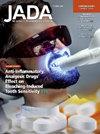儿童白血病患者的口腔表现:系统回顾和荟萃分析。
IF 3.1
2区 医学
Q1 DENTISTRY, ORAL SURGERY & MEDICINE
引用次数: 0
摘要
背景:白血病是儿童患者中最常见的恶性肿瘤,而且会累及髓外组织。文献中也有关于口腔表现的报道,但据作者所知,还没有系统性综述介绍过这些表现的普遍流行情况。本综述旨在确定儿童白血病患者口腔表现的患病率:作者检索了 PubMed-MEDLINE、Embase、拉丁美洲和加勒比海健康科学文献、Web of Science 和 Scopus。此外,作者还对灰色文献进行了检索,并对纳入研究的参考文献目录进行了人工检索。纳入标准是调查儿童白血病患者口腔病变发生率的观察性研究。两名独立审稿人将所选文章中的数据收集到事先编制好的 Excel(微软)电子表格中:结果:67 项纳入研究共报告了 79 种口腔表现。急性淋巴细胞白血病患儿在治疗期间最常见的改变是龋齿(81%),证据的确定性为中等。牙龈炎发病率为 73%,口腔黏膜炎发病率为 50%,淋巴结病发病率为 45%,证据确定性极低。治疗后,牙齿畸形的发生率为 61%,最常见的是釉质发育不全(40%)、牙齿缺失(22%)和小牙畸形(22%),证据的确定性很低。研究之间的高度异质性大大降低了证据的确定性:本研究结果表明,儿童白血病患者主要在治疗期间和治疗后出现口腔表现。医护人员必须了解口腔表现,并在肿瘤治疗期间将患者转介给牙科医生。因此,牙医必须为儿童白血病患者提供支持,帮助他们确保更好的生活质量。本文章由计算机程序翻译,如有差异,请以英文原文为准。
Oral manifestations in pediatric patients with leukemia
Background
Leukemia is the most common malignancy in pediatric patients, and it has extramedullary involvement. Oral manifestations have been reported in the literature, but to the authors’ knowledge, no systematic review has presented the general prevalence of these manifestations. This review aimed to determine the prevalence of oral manifestations in pediatric patients with leukemia.
Types of Studies Reviewed
The authors conducted a search of PubMed-MEDLINE, Embase, Latin American and Caribbean Health Sciences Literature, Web of Science, and Scopus. Additional searches were carried out in the gray literature and via hand searching of reference lists of included studies. The inclusion criteria were observational studies that investigated the prevalence and occurrence of oral lesions in pediatric patients with leukemia. Two independent reviewers collected data from the selected articles in a prepiloted Excel (Microsoft) spreadsheet.
Results
From 67 included studies, 79 oral manifestations were reported. The most frequent alteration in children with acute lymphoblastic leukemia during the treatment were caries (81%), with moderate certainty of evidence. The prevalence of gingivitis was 73%, oral mucositis was 50%, and lymphadenopathy was 45%, with very low certainty of evidence. After the therapy, the prevalence of dental anomalies was 61%, and the most common were enamel hypoplasia (40%), dental agenesis (22%), and microdontia (22%), presenting very low certainty of evidence. The high heterogeneity among studies contributed significantly to reduce the certainty of the evidence.
Practical Implications
The findings of this study show that pediatric patients with leukemia have oral manifestations predominantly during and after treatment. Health care professionals must be aware of oral manifestations and refer the patients to dentists during the oncological treatment. Thus, the dentist must support pediatric patients with leukemia to help ensure a better quality of life.
求助全文
通过发布文献求助,成功后即可免费获取论文全文。
去求助
来源期刊

Journal of the American Dental Association
医学-牙科与口腔外科
CiteScore
5.30
自引率
10.30%
发文量
221
审稿时长
34 days
期刊介绍:
There is not a single source or solution to help dentists in their quest for lifelong learning, improving dental practice, and dental well-being. JADA+, along with The Journal of the American Dental Association, is striving to do just that, bringing together practical content covering dentistry topics and procedures to help dentists—both general dentists and specialists—provide better patient care and improve oral health and well-being. This is a work in progress; as we add more content, covering more topics of interest, it will continue to expand, becoming an ever-more essential source of oral health knowledge.
 求助内容:
求助内容: 应助结果提醒方式:
应助结果提醒方式:


